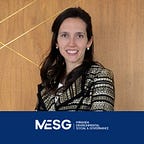The new options for ESG investing in Mexico
July 23rd, 2020
This week I want to portrait two new ESG funds available in Mexico: one from Santander Asset Management which will follow Santander’s global methodology for ESG integration in Mexican equities (with an active management approach) and one from Blackrock together with Citibanamex which will offer Mexican clients access to Blackrock’s global ESG portfolio suite (combining both equities and fixed income).
Let’s first talk about Santander’s fund.
We had a conversation with Jesus Mendoza del Rio (Head of SAM in Mexico) and Rafael Buerba (Equities PM for SAM in Mexico) about this launch. They spoke about how SAM has done a ton of work on ESG globally. According to their numbers, SAM has around EU$5bn in AUM dedicated to ESG strategies which follow a proprietary model to integrate ESG into the investment process (this model considers ~130 ESG factors). The idea then is to bring this model to Mexico, take advantage of the global team’s expertise in rating companies for their ESG performance, and tropicalize it with the local knowledge of the equities team finding attractively valued stocks.
There will be no ETFs involved in this fund, it will be purely active management with no thematic inclination. There will only be a few sectors excluded from the investment universe (like weapons, drugs, alcohol, etc.), and depending on the sector certain ESG factors will be given more weight than others in the ratings process. So far, the team has ESG data on 103 issuers in Mexico (which to us sounds like a lot given the size of the market and the number of companies who really provide ESG data). Finally, another relevant thing to say is that SAM also believes a fundamental part of this strategy will also be engagement with the companies in the market to show them why they may have a less than ideal rating and what would be the path towards improvement (and better disclosure).
The fund is being formally launched today, July 23rd, in the Mexican Stock Exchange (BMV). Fundraising has been going on for a few weeks now, and ideally the team would like to reach US$100m in AUM for this kind of strategies over the next 12 months.
What about Blackrock/Citibanamex?
This week we also heard from the largest asset manager globally (and the most vocal on ESG issues recently) regarding a new option for investors in Mexico who want to move towards a sustainable strategy. This new fund (BLGLO31) will be a combination of both global fixed income and global equities with an MSCI-backed ESG methodology, and which according to Blackrock was designed with Mexican clients in mind. It has been available since July 13th, but just recently formally launched, and the expectation is that over time it will generate a lot of interest in all those who want to invest with both good returns and sustainability notions in mind.
Let’s hope in the next few months both strategies gain a lot of visibility (and assets under management) and the ESG movement grows in Mexico. This in turn will make companies more interested in being better at disclosing ESG info and improving their ESG strategies towards international best practices.
It will be important to see how the funds work in practice. Many fund managers launch ESG funds as a marketing strategy to raise money do not do much original ESG research bar following public ESG ratings scores. Clearly SAM has a global platform that goes materially beyond this (and so does Blackrock). Thus, the interesting thing to follow will be how these global methodologies can be tropicalized to Mexico, where data is scarce to begin with in SAM’s case and investors are less acquainted with the topic than in other places in Blackrock’s case.
I hope you found this useful. As usual, if there is anything we can help you with, please reach out.
Best,
Marimar
Partner, Miranda ESG
